| Warning |
|---|
The following formatting instructions identify specific requirements for papers submitted for the Drew DMIN program. Please consult your advisor for the specific formatting requirements that apply to your paper and adjust the directions where needed. These instructions are also written using Word 2013. If you use a different version of Word - especially Word 2011 for Mac - your options may be found in a different place, though they will go by the same name. Visit support.office.com to learn more about any setting you cannot find. |
Paragraph marks can be helpful to see when something is not responding to formatting the way you expect it to. These can be turned on and off by clicking the paragraph marks symbol,  , in the Paragraph group on the Home tab of the ribbon. , in the Paragraph group on the Home tab of the ribbon. Text| Expand |
|---|
Your entire document has the same font, so apply these settings before you write. | Your text should be set to Times New Roman, size 12. |  | | Spacing should be double (2.0). | 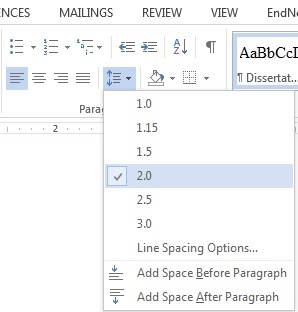 |
|
Page Margins| Expand |
|---|
Your entire document should have the same page margins, so set the page margins before you write. | Go to Page Layout > Margins > Custom margins…. | 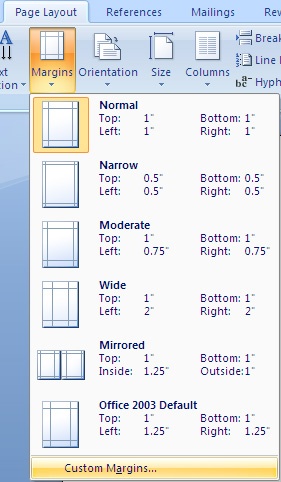 | | Set the margins as follows: 1” margins top, bottom, right; 1.5” left | 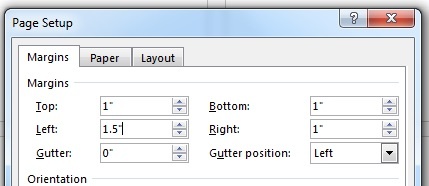 |
|
Title Page| Expand |
|---|
Click the Center alignment button in the Paragraph group on the Home tab of the ribbon ( ). ). Type out your title, entirely caps (use Caps Lock) Type the other information, matching the sample provided to you (not all caps) Right click on first line of title Choose "Paragraph…." from the menu Make sure "Special" is set to "(none)". Set "Line spacing, Before" to 108 pt. (This creates a 2.5” space at the top of the page) 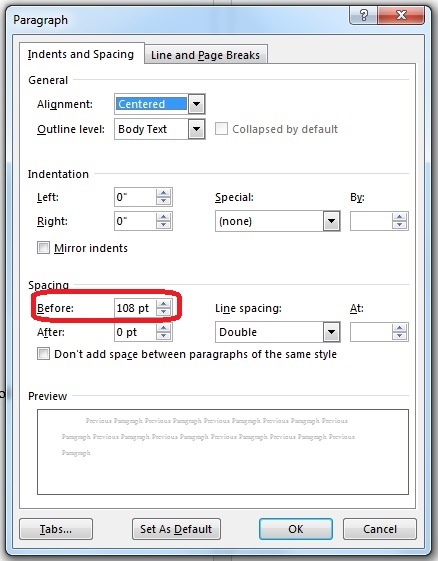
Click OK.
Add blank space between each section of text by hitting Enter until your date is at the bottom - Hit Delete or Backspace once if the date goes on to the next page
|
Body Paragraphs| Expand |
|---|
Type out your first sentence (even if you plan to change it later!) Right click on the sentence and select "Paragraph…." from the menu. Set "Special" to "First Line" It should default to 0.5”, but set it to that if not 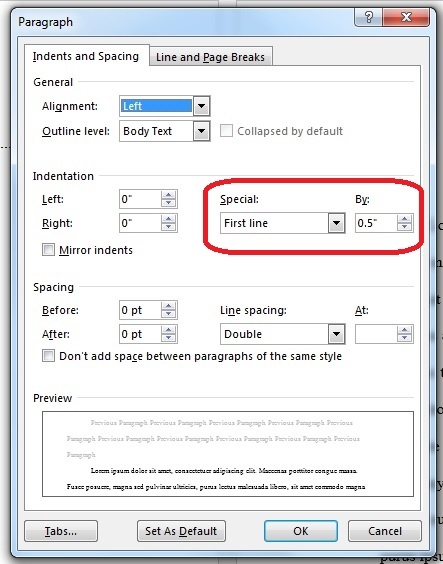
- Click OK
|
| Expand |
|---|
Chapter titles should be in all caps, centered If naming chapters "CHAPTER 1: CHAPTER TITLE", type CHAPTER 1, hit Enter, then type CHAPTER TITLE
2” from top of page: Right click on (first line of) chapter title and select "Paragraph…." from the menu "Special" should be set to "(none)" Spacing > "Before:" should be set to 72 pt (to begin the title 2" from the top of the page) Select the "Don't add space between paragraphs of the same style" checkbox. 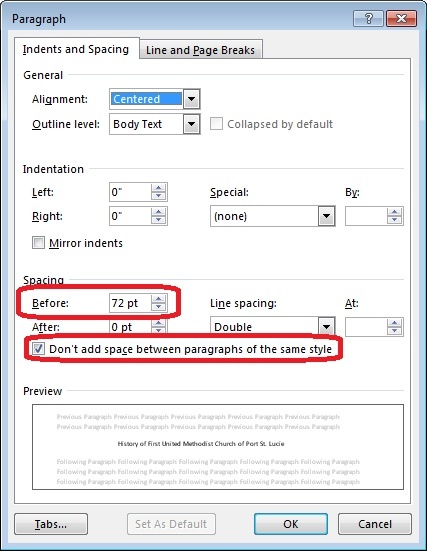
If it doesn’t look like your title moved, turn on paragraph marks and make sure there is a section break at the end of the chapter before
|
| Expand |
|---|
For quotes longer than 3 typed lines (check your guidelines for clarification), the quote should be set apart as a block quote. To do this: - Make your quote its own paragraph.
- Right click anywhere in the paragraph and select "Paragraph…." from the menu.
- Set the Left Indentation to 0.5".
- Set the Right Indentation to 0.5".
- Make sure Special is set to (none).
- Set the Line spacing to Single.
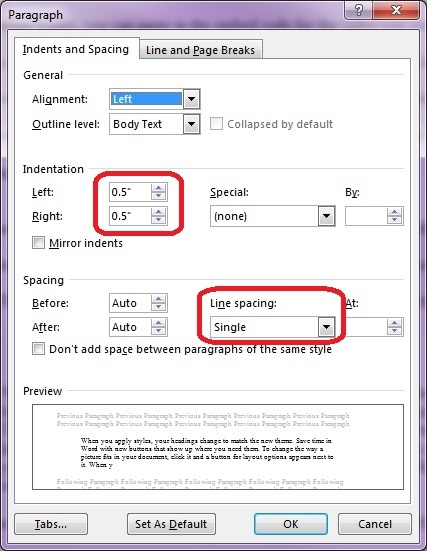
- Click OK.
|
| Expand |
|---|
Some guidelines suggest a 3-em dash be used in the bibliography/works cited in place of repeating an author's name. To insert a 3-em dash: - Put your cursor where you need the line.
- Go to the Insert tab.
- Click on Symbol (to the right) and choose More Symbols.
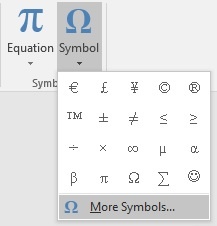
- Click on Special Characters at the top.
- The first character is usually the em dash, which is what we want. Click Insert 3 times (slowly - if you go too fast, it won't insert 3).
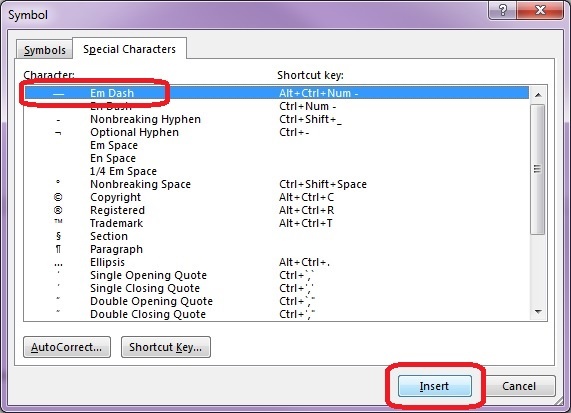
- Click Close, then type your period, space, and the rest of your reference.
|
Adding Section Breaks (for page numbering and footnotes)| Expand |
|---|
Create sections to handle page numbering and restarting footnote numbers at 1 in each chapter. - The title page and any un-numbered pages in the front matter should be a section
- The Table of Contents and any numbered pages in the front matter should be a section
- Each chapter should be its own section
- Each appendix, if you have any, should be its own section
- The Bibliography should be its own section
To add a section break: Put your cursor at the end of the first section (for example, after your abstract) On the Page Layout tab, select Breaks > Next Page (under Section Breaks) 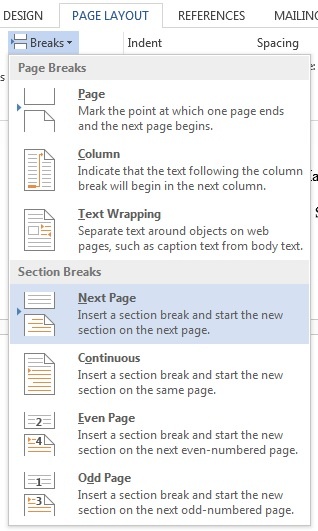
If you get an extra line before the next page’s title, hit (forward) Delete - Word will remember the formatting you create in a section for page numbers and footnotes, so you can set up the formatting for the first few sections, then add sections for additional chapters as you write without needing to manually adjust the page number and footnote settings in each chapter
|
| Expand |
|---|
To insert, put cursor where footnote number should be On the References tab, choose "Insert Footnote" 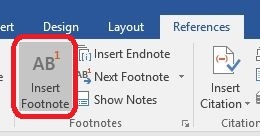
Formatting your footnotes: First, change your view. On the View tab, select Draft. 
On the References tab, choose Show Notes. 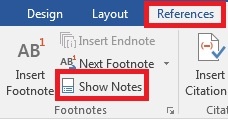
At the bottom, make sure the drop down says "All Footnotes". Click in a footnote and then hit Ctrl+A on your keyboard to select all. Right click in highlighted text and select "Paragraph…." from the menu Adjust the following settings: Alighnment: Left Indentation, Left and Right: 0” Indentation, Special: First Line, 0.5” Spacing, Before: 0 pt Spacing, After: 12 pt Line spacing: Single 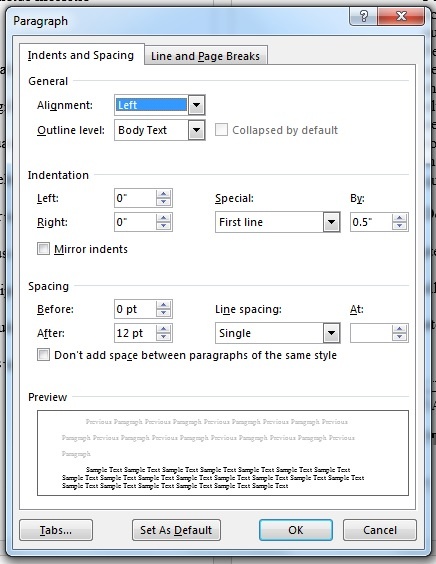
Click OK To return to your usual view, go back to the View tab and choose Print Layout.
To restart footnote numbers for each chapter: Right click on a footnote and select “Note options” In Numbering, select “Restart each section” In Apply changes to, select “Whole Document” - Click Apply.
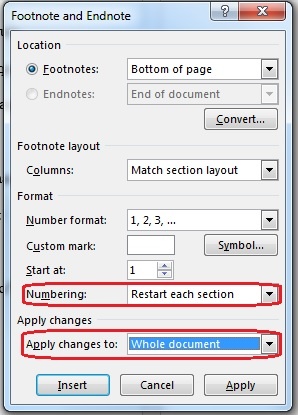
|
Page Numbering| Expand |
|---|
Front Matter page numbers In the second section (after your title page, etc), double click in the Footer (at the bottom of the page, beneath your text). In the Header & Footer Tools Design tab, if “Link to Previous” is highlighted, click on it to turn the link off 
To insert the page number bottom center on the Table of Contents, select Page Number > Bottom of Page > Plain Number 2 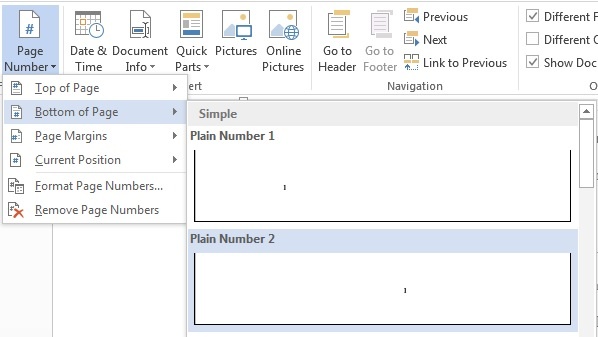
To change the format, select Page Number > Format Page Numbers… Change Number format to lowercase Roman numerals Leave Page Numbering at “Continue from previous section” (as you want to count the title page, etc, in your numbering but do not want numbers to appear on the pages before the table of contents) Click OK 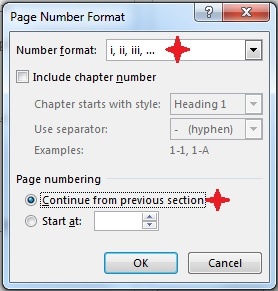
Close Header and Footer to return to editing your text
Main Text page numbers Double click in the footer on the first page of your main body of text In this third section (usually your introduction), if “Link to Previous” is highlighted, click on it to turn the link off 
In following sections, the Link can remain on. Check the box next to “Different First Page” 
To insert the page number bottom center on the first page, select Page Number > Bottom of Page > Plain Number 2 
To start the number at 1, select Page Number > Format Page Numbers… Make sure Number format is set to Arabic numerals Change Page Numbering to “Start at” and enter 1. Click OK 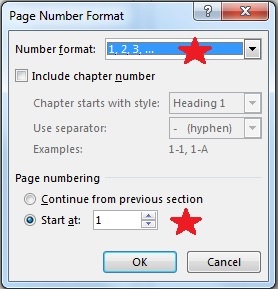
The sections after your introduction or first chapter should be set to "Continue from previous section", as the numbering will keep going rather than starting again at 1.
Click in the Header on your next page If “Link to Previous” is highlighted, click on it to turn the link off 
In following sections, the Link can remain on. To insert the page number on the top right of the page, select Page Number > Top of Page > Plain Number 3 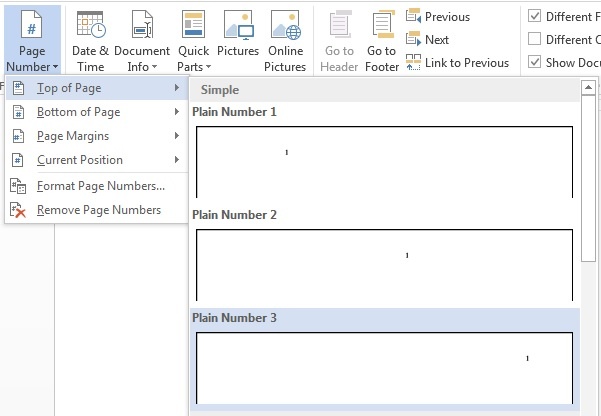
Close Header and Footer On the first page of your next chapter, double click in the header or footer Make sure “Different first page” is checked 
Link to previous should remain highlighted 
The page numbering should continue automatically, with the first page of the chapter bottom center and the other pages top right, for each section. Double check that the Different first page is checked for each section and the page numbers are correct, adjusting if needed.
|
If you are including images in your paper, you can read how to add captions in Word in this article (applies to Word 2007, 2010, 2013, and 2016). This YouTube video from Office gives you some tips for including images in your Word document: https://www.youtube.com/watch?v=pPlBSv5C83M Table of Contents| Expand |
|---|
Save the Table of Contents (TOC) for last, as you should have your paper mostly written before completing your TOC. Make sure your TOC chapter titles match the titles in your text. Dot leaders are the dots between your chapter title and the page number that chapter starts on. The page numbers will be flush right after adjusting these settings.
Type all of the chapter titles, one per line Highlight all of the titles Right click and select “Paragraph….” Choose Tabs… 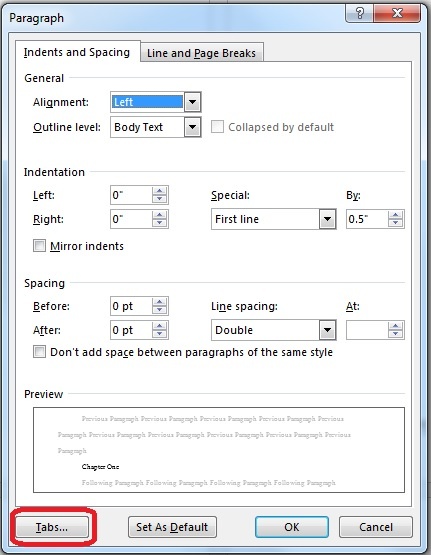
In “Tab stop position”, type 6” Set the Alignment Right Choose Leader 2 (the dots) Click Set, then OK 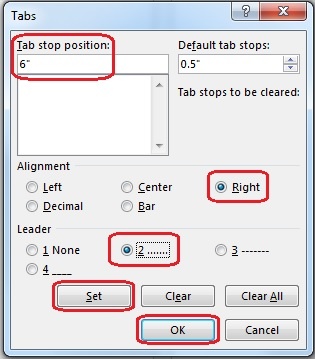
Put your cursor at the end of the first title and hit the Tab on your keyboard Dots will be inserted all the way to the right margin. Type your page number here. Repeat the Tab and page number for each title
|
| Expand |
|---|
Please confirm this order with your adviser. Also keep in mind that not all of these elements are necessary for your paper. Again, confirm requirements with your adviser. Theological School: Front Matter Title page; Copyright; Abstract; Dedication (no page numbers) Table of Contents; Figure List; Acknowledgements; Abbreviations; Glossary* (lower case Roman numerals) Back Matter Appendix/ces; Glossary*; Bibliography (Arabic numerals) Graduate School Front Matter Title page; Copyright; Abstract; Dedication (no page numbers) Table of Contents; Acknowledgements; Other (figure list, abbreviations, preface) (lower case Roman numerals) Back Matter Appendix/ces; Glossary*; Bibliography (Arabic numerals) CV (no page number) * The Glossary can be placed with the front matter or back matter |
|


























